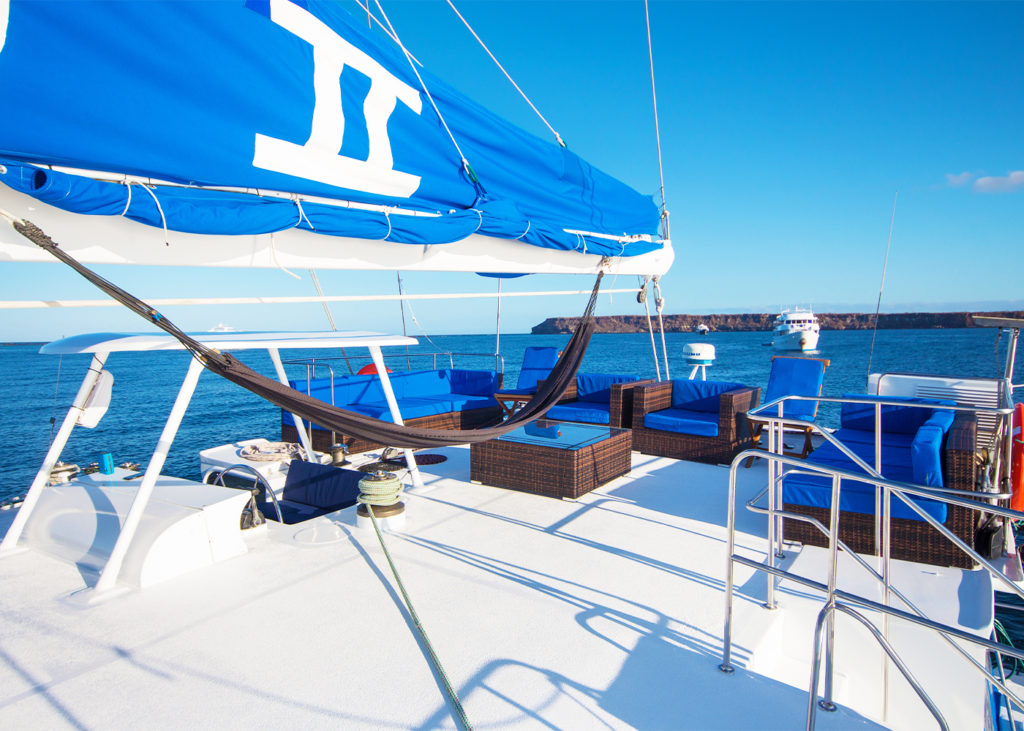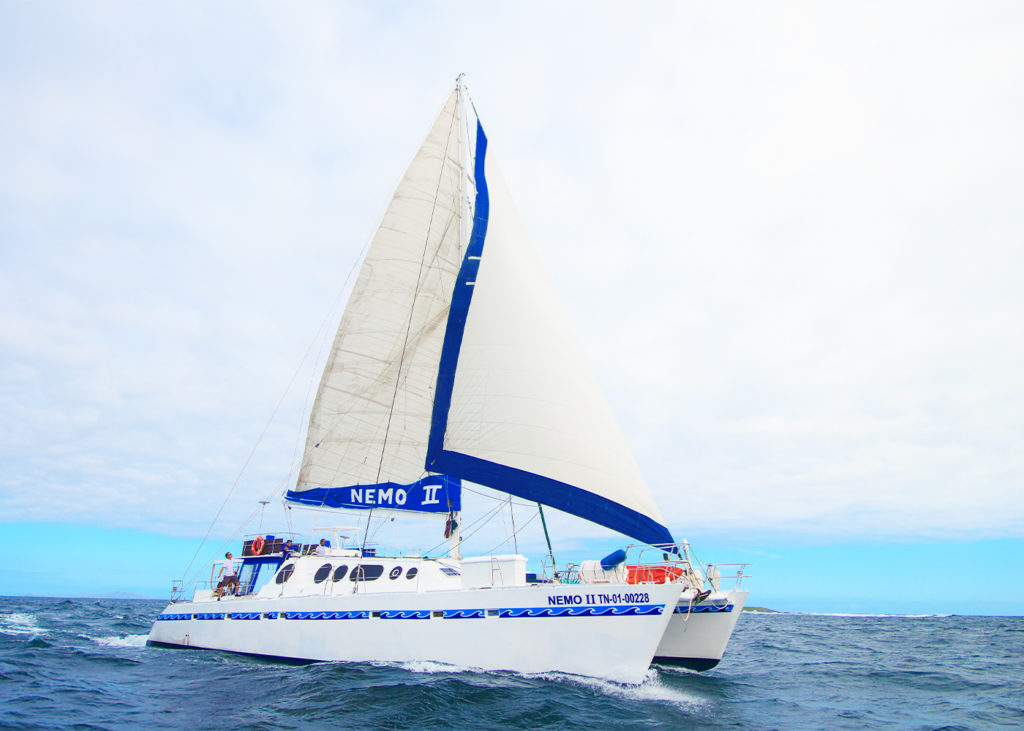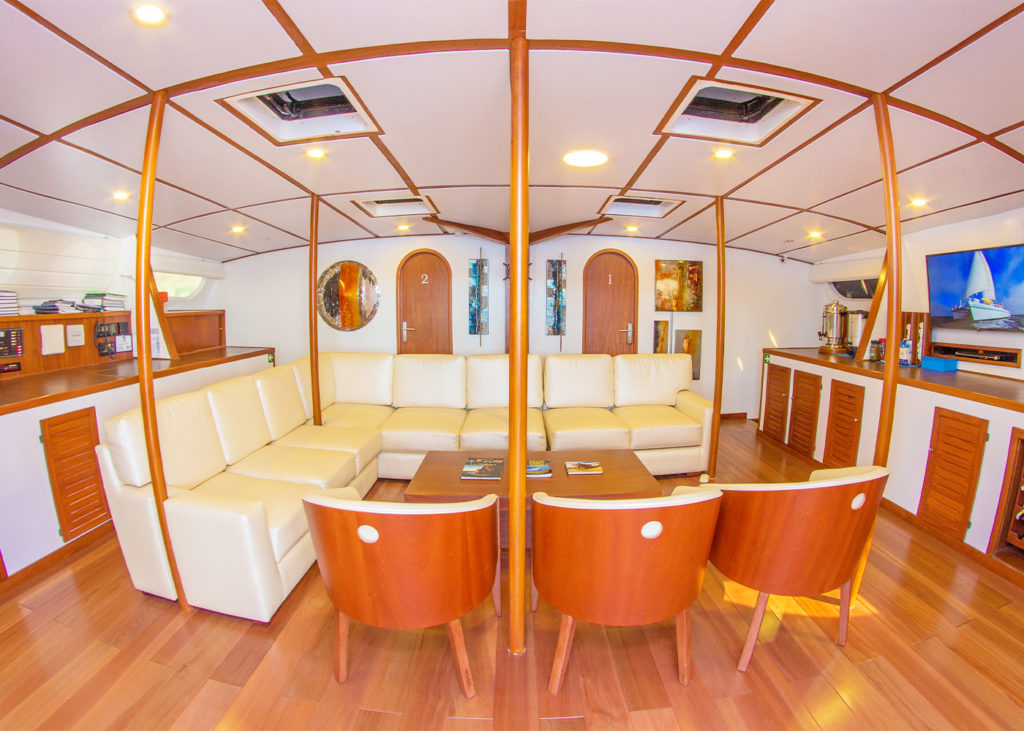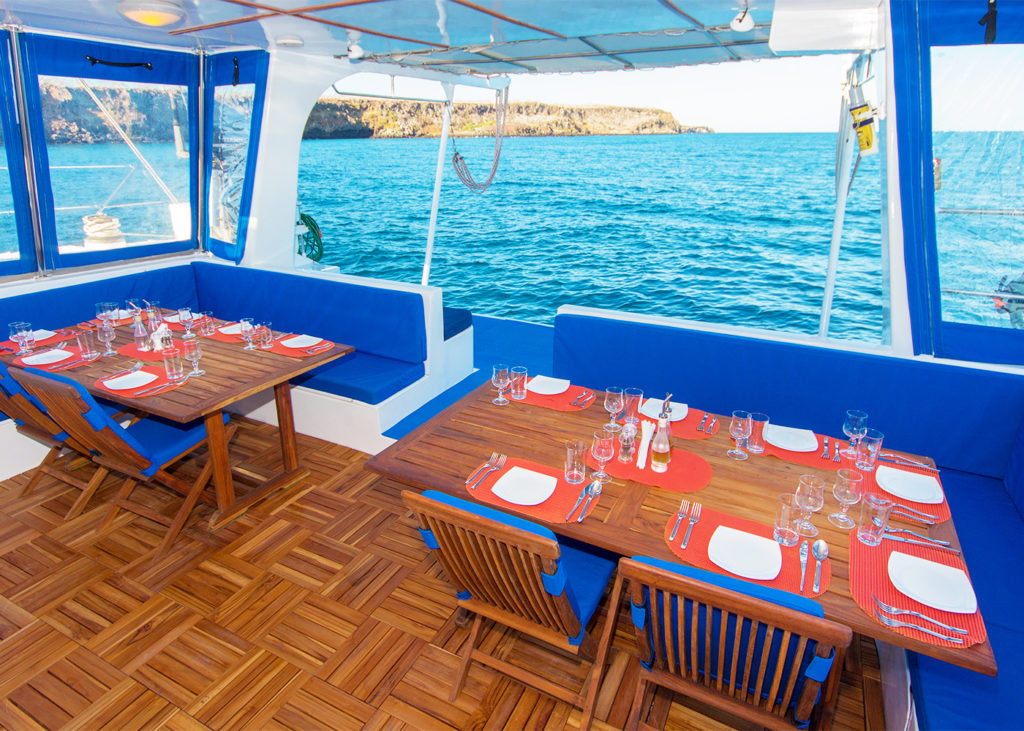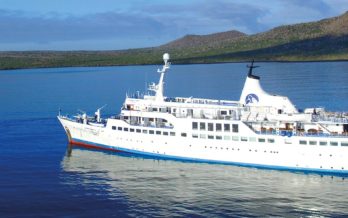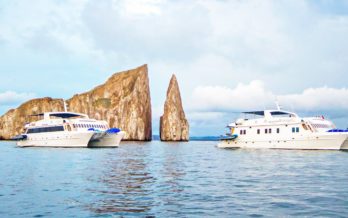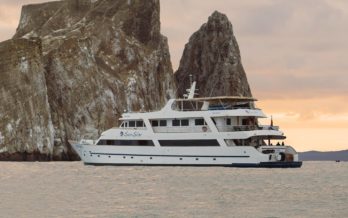Cruise Overview
The Nemo II is an incredibly unique 72 ft.(22 meters) multihull sailing catamaran with capacity for 12 people.
All its cabins, which are different in configuration and size, have been carefully fitted to ensure passenger comfort. All cabins have a private bathroom and self-regulated air conditioning.
The skillfully designed saloon and the unique size of this beautiful catamaran make it an exceptional choice for cruising in the Galapagos while offering excellent stability and service.
This unique vessel features a charming sundeck, elegant social areas and a well-stocked bar that will complete your Galapagos experience.
Cabin Types & Social Areas
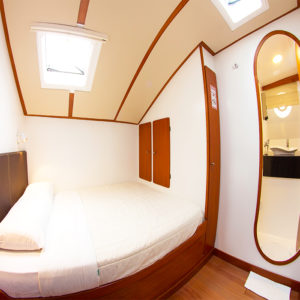

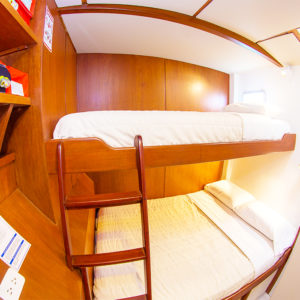
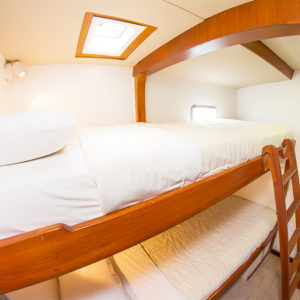
Northern Itinerary
Departs Sundays
Arrival to the airport in Baltra, reception by the cruise guide and transfer to the yacht. Navigation to Seymour , (North of Baltra) The visitor trail on North Seymour is approximately (2 km) in length crossing the inland of the island and exploring the rocky coast. Along the way the trail passes colonies of Blue-Footed Boobies and Magnificent Frigatebirds. The Magnificent Frigatebird, a large black bird with a long wingspan, and a hooked beak, is extremely fast and has excellent vision. Frigatebirds are known for the large red pouch on their necks. Boobies and Frigates share an interesting relationship. Sharing the same nesting area on North Seymour Blue- Footed Boobies nest on the ground making their nests from the twigs of the Palo Santos Trees, while the Magnificent Frigate bird nests just above them in the saltbushes. In the night, dinner and navigation to Santa Cruz.
Morning Excursion:
The highlands of Santa Cruz have incredible zones of vegetations. There you will visit the private finca “Las Primicias”. This reserve offers you one of the best possibilities to see the huge turtles of Santa Cruz Island in their natural habitat. You can observe them from very close.
Afternoon Excursion:
In the afternoon visit Charles Darwin Scientific Station. An excellent way to begin learning about the islands and their origin and formation is to visit the Station. You can also see how the Galapagos turtles are raised and meet Jorge, the famous solitary turtle. The Scientific Station has its own beach that receives many visitors on weekends.
Morning Excursion:
A colorful part to any tour located on the western shore of Isabela, Punta Moreno is often the first or last stopping point on the island (depending on the direction the boat is heading). Punta Moreno is a place where the forces of the Galapagos have joined to create a work of art. The tour starts with a panga ride along the beautiful rocky shores where Galapagos penguins and shore birds are frequently seen. After a dry landing the path traverses through jagged black lava rock. As the swirling black lava flow gave way to form craters, crystal tide pools formed-some surrounded by mangroves. This is a magnet for small blue lagoons, pink flamingos, blue herons, and Bahama pintail ducks. Brown pelican can be seen nesting in the green leaves of the mangroves. You can walk to the edge of the lava to look straight down on these pools including the occasional green sea turtle, white-tipped shark and puffer fish.
Afternoon Excursion:
Lying at the foot of Alcedo Volcano, south of Tagus Cove, is Urvina Bay (Urbina Bay) one of the best and the most recent example of geological uplift in the Galapagos. Uplift occurs when the molten materials beneath the surface shifts. In 1954 the shoreline was uplifted nearly 15 feet (4 meters). The coastline was driven 3/4 of a mile further out to sea, exposing giant coral heads and stranding marine organisms on what was now on shore. A Disney film crew visited the site shortly afterwards and discovered skeletons of sharks, sea turtles and lobsters unable to find the ocean from the rapidly rising land. Schools of fish were found stranded in newly formed tide pools. Boulder sized coral heads can be seen near the area that once was the beach. The uplifting of Urbina Bay was followed by an eruption of Alcedo a few weeks later.
The visit begins with a wet landing on the white sand beach. Difficulty of the route varies by season. The trail ranges from stark and easily passable during the dry season to mildly challenging requiring wading to pass during the rainy season. Visitors cross the uplifted region learning about this geological wonder. Then reach the sandy area that was once the beach. Shorter visits return to the landing point on the same path, while longer visits continue past the coral heads and new beach.
Morning Excursion:
Isabela Island is situated directly east of Fernandina Island on the west coast of Isabela Island. It is a beautiful, well-protected cove sheltered by the shoulders of two volcanic craters and has been used as an anchorage for over 300 years. A nature trail here ascends through the typical dry vegetation zone and offers spectacular views of Darwin Lake, a saltwater crater lake and the long narrow inlet that appears to connect with it. At the top of the trail it is possible to observe the different vegetation zones, catch a glimpse of Darwin and Wolf volcanoes, and observe Galapagos penguins, Flightless cormorants and pelicans.
Afternoon Excursion:
Fernandina Island is the youngest and most active volcano in the Galapagos, with eruptions taking place every few years. The flat lava of Punta Espinosa offers a stark and barren landscape, but here flightless cormorants build their nests on the point, sea lions sprawl on the beach or play in the tide pools and large numbers of marine iguanas dot the sand. We also will have the opportunity to compare the aa and pahoehoe lava types here.
Morning Excursion:
A visit to Puerto Egas begins with a wet landing on the dark sand beaches of James Bay. The visit begins with a walk along the rocky coast giving visitors the opportunity to view some of the Galapagos Island’s best tide pools. Sponges, snails, hermit crabs, barnacles and fish including the endemic four-eyed blenny can be seen. The walk also presents visitors with a variety of shore birds, marine iguanas, sally light foot crabs and sea lions.
There are two interesting excursions normally visited from Puerto Egas. The first is a short walk from the landing site brings visitors to the site of one of the Galapagos’ first entrepreneur endeavors. For decades salt was extracted from a local salt crater. The industry was abandoned in the 1950’s leaving behind a variety of rusted old machines and parts of buildings. The trail follows the path once used by wagon trains to the crater cone.
The steep trail is easy, but can often seem one of the hottest hikes in the islands. Feral goats prune the arid vegetation, which lines the trail. The goats feed on any leaf within reach leaving little left for the endemic island creatures. Bird lovers will be delighted with the opportunity to catch a glimpse of one of Darwins finch, the endemic Galapagos hawk, or the colorful vermillion flycatcher.
Finally reaching the crater rim presents an incredible vista. Looking into the crater you are able to see this extinct volcano whose floor has sunken below sea level. Salt water seeps into the crater creating a small salt lake. The sun evaporates the water, leaving the salt that many have tried to mine without success.
Afternoon Excursion:
Visitors who now come to Espumilla Beach come in search of birds rather than water. A short walk inland takes visitors through a mangrove forest normally inhabited by the common stilt. Sea turtles also visit these mangroves to nest. Beyond the mangroves is a brackish lagoon where flocks of pink flamingos and white cheeked pintails can be seen.
The trail makes a loop heading over a knob into a sparely forested area then back to the beach. Along the way those with a watchful eye may spot a variety of Darwin finches or a vermilion fly catcher. Once back at the beach visitors may have the chance to swim or snorkel time permitting.
Less than an hour north of Puerto Egas, Buccaneers Cove served as a safe haven for pirates, sailors and whalers during the 18th and 19th century. Anchoring in the protected bay they were able to make much needed repairs to their ships while other men went a shore to stock up on salt, tortoises, fresh water and firewood. Several years ago ceramic jars were found at the bottom of the bay, the disregarded cargo of some mariner from years gone by. Inside the jars were supplies of wine and marmalade.
Few boats stop at Buccaneers Cove today. Though many cruise by at a slow speed giving visitors the opportunity to view the steep cliffs made of tuff formations and the dark reddish-purple sand beach. This dramatic landscape is made all the more impressive by the hundreds of seabirds perched atop the cliffs. Two of the more recognizable rock formations are known as the “monk” and “elephant rock”. A large population of feral goats now frequents Buccaneers Cove and this portion of Santiago. The National Park Service has fenced off part of the area to protect the native vegetation from the destructive eating habits of this introduced species.
A wet landing on the large coffee-colored sand beach is just north of the prized fresh water supply that once attracted pirates and whalers.
One of the special features of Rabida Island is its remarkable red color, which is a result of the high percentage of oxidized iron in the composition of lava. Here we will witness the nine varieties of finches also the large-billed flycatchers and brown pelicans. Here a small salt-water lagoon where greater Flamingos can be seen and a beautiful colony of sea lions.
The main attraction of this bay is the broad, pahoehoe or rope lava flow. It is one of the most incredible places to compare the lava flows and their characteristics.
Morning Excursion:
Also known as bird Island: EL BARRANCO, This is a demanding walk up a steep cliff, where tropicbirds, red-footed boobies and other nesting seabirds can be found. We follow the trail through a palo santo forest to a storm petrel colony passing boobies and great frigate bird along the way.
Afternoon Excursion:
DARWIN BAY, is the caldera of a collapsed volcano, we land on a small coral beach, were we take an easy walk. For those that want this will lead into a more demanding walk over lava rock. This will allow for stunning views from the cliffs and allow apple time and opportunity to photograph the amazing bird life such as swallow-tailed gulls, red-footed booby, nazca booby, large ground finch, large cactus finch, sharp-billed ground finch, small marine iguanas, and great frigate bird.
Morning Excursion:
Among the central islands of the Galapagos Archipelago, Islas Daphne sits north of Isla Santa Cruz and west of Isla Baltra. Actually two islands known as Daphne Major and Daphne Minor, Islas Daphne is one of the more accessible Galapagos Islands. Easily reached by most tour boats and cruises, disembark in this this island is NOT POSIBLE . We are going to sail around
Breakfast transfer tp Baltra airport end of the services.
Tour Inclusions
- Accomodation double cabins with private bathroom
- Meal as per itinerary
- Guided visits to sites of interest by a naturalist
- Naturalist guide level III
- Snorkeling equipment
Tour Exclusions
- Round trip flights from mainland Ecuador to Galapagos Islands
- Galapagos National Park admission fee approx. US $100 per person
- Galapagos Transit Control Card approx. US $20 per person
- Tips
